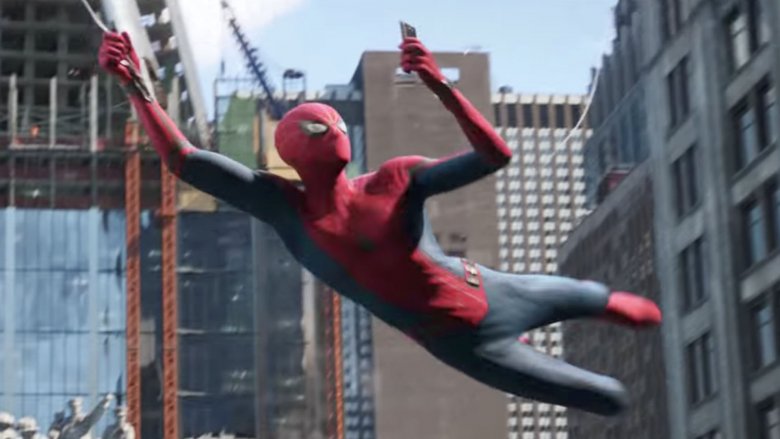That Spider-Man: Far From Home Mid-Credits Twist Was Supposed To Happen Much Earlier
That big reveal in Spider-Man: Far From Home almost happened very differently.
In a recent conversation with the New York Times, screenwriters Chris McKenna and Erik Sommers related that while the shocking twist had always been part of the plan, certain elements changed throughout the writing process — including the timing. Just in case that isn't warning enough, please be advised that spoilers for Spider-Man: Far From Home follow.
At the climax of the flick, Peter Parker (Tom Holland) was able to shut down the illusion of the rampaging elemental being projected by the Stark drones which had been commandeered by Quentin Beck/Mysterio (Jake Gyllenhaal) and his team of fellow disgruntled former Stark Industries employees. Mysterio's risky maneuver — placing himself in the line of the drones' fire in a last-ditch effort to defeat Spider-Man — ended in his apparently being mortally wounded, and Spidey emerged victorious.
But the film's mid-credits sequence revealed that the victory was destined to be short-lived. Apparently, Mysterio (or someone close to him) had leaked doctored footage of the battle to DailyBugle.net's J. Jonah Jameson, making it appear as if Mysterio really was the hero his orchestrated attacks were meant to portray him as, with Spidey being the ruthless villain behind said attacks. To add insult to injury, Mysterio (with his maybe-dying breath) named Peter Parker as the guy behind the mask, throwing the wall-crawler's future status among the public into serious question.
According to McKenna, the unmasking of the wall-crawler was always meant to be a plot point — the scribes were just uncertain as to when it should happen. In addition, the framing of Spidey for Mysterio's crimes was a story beat that almost didn't make it into the film at all.
"We were wondering, 'Are we going as deep as we need to at the end of the movie?'" the writer explained. "We played with the idea that Peter is the one who sacrifices his identity out of necessity during the final battle, then it seemed more interesting if Mysterio tricks him into doing it, but any time we wrote a version where he was being revealed to the world in that battle, it felt like it diminished the victory. So before it became a tag, it was really just the end of the movie: Right as he feels he's stepping up as Spider-Man, he has the rug pulled out from under him again."
Sommers went on to explain that while the pair went back and forth as to whether ol' webhead should simply have his identity revealed or... worse, they eventually decided (true to his comic book form) that young Mr. Parker needed to be saddled with the most unlucky turn of events possible.
"We were definitely debating, should we just reveal who Spider-Man is, or should we frame him for something and turn him into a pariah?" he said. "Ultimately, we decided that both was the way to go. It's such a triumph at the end because he's got the girl and finally earned a big swing through the city, so we want to knock him down as far as possible."
A bold, but appropriate, choice: anybody who grew up reading Spider-Man comics knows that when the webslinger is on top, he isn't going to remain there for very long. The twist also served an excellent narrative purpose, opening up a giant can of worms (or spiders, if you will) for the hero and opening up an array of potential problems and conflicts for him to face in future films. Also, it's worth mentioning that there's no more ideal figure to declare Spidey a menace to the public than Jameson, and the unmasking/framing scenario offered the filmmakers the perfect opportunity to once again cast J.K. Simmons — who famously portrayed the hard-headed newsman in all three of Sam Raimi's Spider-Man pictures — in the role, a cameo that fans went bonkers for.
There is still, however, one lingering question which the ace screenwriting duo didn't address: who slipped that doctored footage under Jameson's door, so to speak? It'd be pretty easy to simply hand-wave this point; all it would take is one throwaway line of dialogue in a future film to pin the leak on a member of Mysterio's team. But we find it more likely that the villain himself, the master of illusion and misdirection, is almost certainly responsible — because he's not really dead. While previous Spider-Man movies had a bad habit of killing off awesome villains in their first appearances (see: Willem Dafoe's Green Goblin in 2002's Spider-Man), McKenna and Sommers have not thus far appeared to be so inclined. They left Michael Keaton's Adrian Toomes/Vulture alive at the end of Spider-Man: Homecoming, after all — and knowing Mysterio, faking his own death seems like it'd be a vital component of any contingency plan he might have had, should his plans fail.
Of course, we'll have to wait until Spidey's next appearance in the MCU to get an idea how it's all going to shake out. But, we're going to go ahead and go on record: Gyllenhaal is a big-name actor, his performance in Far From Home was simply awesome, and his character never met a fakeout he didn't love. If Mysterio doesn't return to vex Parker again at some point in the future, we'll eat a pine cone with a nice vinaigrette.
